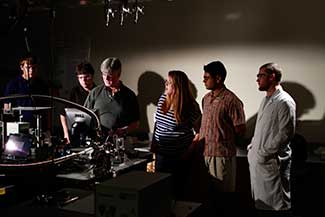UWG Develops Research That Plays Important Role in Today’s Economy
The University of West Georgia’s College of Science and Mathematics is making prodigious strides in studying the properties and behavior of amorphous materials. These are an increasingly important class of materials to today’s economy.
 Amorphous materials lack order on the molecular level found in true solids. Recent advances in amorphous semiconductors, superconductors and metal glasses are finding important technological applications, and their significance is reflected in the awarding of the 2011 Nobel Prize in Chemistry. This research could also have a significant impact in biology, since proteins share much in common with amorphous solids. In these investigations, the UWG researchers study supercooled solutions just above their glass transition temperature; these are solutions that are trapped in the liquid state at temperatures well below their freezing point.
Amorphous materials lack order on the molecular level found in true solids. Recent advances in amorphous semiconductors, superconductors and metal glasses are finding important technological applications, and their significance is reflected in the awarding of the 2011 Nobel Prize in Chemistry. This research could also have a significant impact in biology, since proteins share much in common with amorphous solids. In these investigations, the UWG researchers study supercooled solutions just above their glass transition temperature; these are solutions that are trapped in the liquid state at temperatures well below their freezing point.
The research at UWG’s laser laboratory and the laboratory for low temperature studies in condensed matter chemistry and physics employs two different kinds of probes. The first are hydrogen ions, which are initially “caged” in molecules, and then released by a laser pulse. The second are molecules that undergo a large structural rearrangement when excited by a laser pulse.
“We are trying to understand fundamental processes that occur in supercooled solutions,” says Dr. John Hansen, UWG professor of Chemistry. “Our data will provide important insights for what occurs during a chemical reaction in supercooled and normal solutions.”
This study also allows researchers to address fundamental questions in chemistry and physics without relying on other institutions. UWG is the only university that can provide similar kinds of instruments within a 50-mile radius.
“It is my anticipation that both labs will generate many new opportunities to stimulate interdisciplinary research between chemistry and physics, and perhaps biology,” Dr. Hansen continues. “I hope that this laboratory will serve as a nucleus for carrying out material science research at UWG.”
The establishment of the laser based spectroscopy laboratory was a collaborative effort among several faculty members in the Department of Chemistry, funded by a National Science Foundation grant with a generous institutional match. The ongoing work currently involves Hansen, Dr. Douglas Stuart, assistant professor of chemistry, and a number of undergraduate students.
“This facility is used for instruction in several undergraduate courses and in faculty directed undergraduate research,” says Dr. Farooq Khan, dean of UWG’s College of Science and Mathematics. “Students who have worked in this laboratory have proceeded to pursue graduate work in some of the best programs in the nation.” Many of the students who have worked in the lab continued their graduate education at schools like Harvard, Columbia, Georgia Tech, Stanford, Berkeley and Duke.
“Typically this type of instrumentation is found at a research university such as Georgia Tech or UGA,” Dr. Hansen agrees. “There it is reserved for the use by graduate students only, but at UWG undergraduates are encouraged to participate in research.”
This facility has even created opportunities for high school students. As a high school sophomore and junior, Kaj Hansen completed two research projects to compete in the Intel Science and Engineering Fair.
“I studied how a hydrogen ion concentration gradient across the membranes of thylakoids, found in chloroplasts, would affect the efficiency of electron transport in photosynthesis,” says Kaj. “The following year, I investigated proton mobility in supercooled aqueous polyalcohol solutions. Both projects were extremely well received at the Georgia Science and Engineering Fair.”
Kaj received first place awards both years along with winning a number of special awards. Winning the grand prize in the Physical Sciences at the Georgia Science and Engineering Fair in 2010 allowed him to compete at the Intel International Science and Engineering Fair and paid for his weeklong trip to San Jose, Calif. At the international competition he received third place in chemistry.
“The opportunity to conduct original research in the laser lab afforded me valuable experience that I otherwise would not have been exposed to until the second or third year of college,” says Kaj.
The lab houses a Q-switched Nd:YAG laser, home built and commercially built cryostats, a home built spectrometer, a pump-probe spectrometer and an ultra high vacuum chamber.
For more information, contact Dr. Farooq Khan or Dr. John Hansen in UWG’s College of Science and Mathematics.
